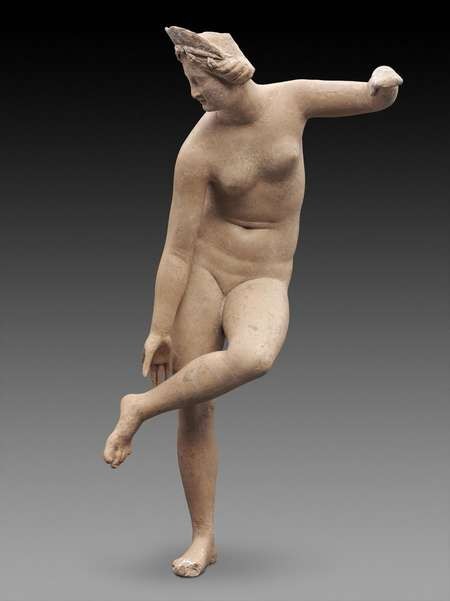Sexy goddess bares all in Boston

by Sean McLachlan
Dec 29th 2011
Photograph: Statuette of Aphrodite untying a sandal (Sandalbinder), Greek, East Greek, Late Hellenistic Period, 1st century B.C., Terracotta. Museum of Fine Arts, Boston. Catharine Page Perkins Fund.
The ancient goddess of love, sex, and beauty is making an appearance at the Museum of Fine Arts in Boston.
Aphrodite and the Gods of Love is a new exhibition examining one of the most popular ancient goddesses and her place in the Classical world. More than 150 ancient works of art are on display, including famous pieces such as the Knidia, a life-size sculpture of Aphrodite made by the 4th-century BC Greek artist, Praxiteles. Another interesting piece is the Sleeping Hermaphrodite, a reclining figure who from one side looks like a voluptuous woman, and from the other like a man.
The exhibition traces Aphrodite's sexy origins in the Near East and the place of her cult in Greek and Roman society. Aphrodite was a Greek goddess who was adopted into the Roman pantheon as Venus. She was the symbol of romantic love and ideal beauty. She also oversaw marriage, an odd choice since many of the myths surrounding her involve her cheating on her husband, the blacksmith god Hephaistos (Vulcan). Men worshiped her because she aroused male virility.
Being in charge of such important aspects of life made Aphrodite extremely popular. She was the patron goddess of Pompeii. Interestingly, Ramsay MacMullen in his Paganism in the Roman Empire points out that altars in private homes in Pompeii were more often dedicated to Foruna, Vesta, and Bacchus than Aphrodite. Perhaps because love received so much public worship, people felt they needed to give good luck, the home, and drinking some attention. They can be related, after all!
McMullen's book (which I highly recommend) also touches on various ways the Romans worshipped Venus, including picnicking in the orchards around her sanctuary in Cnidus, and wild processions where a woman playing Venus led a string of dancing children playing Cupid. She and the other deities were very much part of daily life.
The exhibition also looks at related figures of Classical mythology, such as Aphrodite's sons Eros (Cupid), the well-endowed Priapus, and Hermaphrodite.
If you want to meet this lovely lady and her interesting offspring, you better hurry. Aphrodite and the Gods of Love is only on until February 20, 2012.
Then it will move to the Getty Villa, California, from March 28th to July 9th, 2012.
Following its showing at the Getty, the exhibition will be on view at the San Antonio Museum of Art from September 15, 2012 to February 17, 2013 and at the Philbrook Museum of Art in Tulsa from March 10 to May 26, 2013.
Don't miss it!